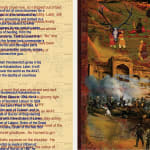


Sheba Chhachhi
218.4 x 81.3 x 15.2 cm
Further images
For both the indigenous rulers of colonial India and British colonialists, hunting was a cultural means to display their power as sovereigns. The hunter's identity was contingent upon the possession and display of trophies, each trophy head representing a singular heroism. Once a royal and feudal sport, today’s global sporting market offers wealthy hunters special ‘stalking tours’ in the western Himalayas. This geopolitically strategic region, once a 19th C colonial battleground became a sporting ground for the big game hunters of the British Raj in the early twentieth century. As in the colonial shikar, the contemporary big game hunter is guaranteed a trophy head often of endangered species like the Hangul, prized for its magnificent antlers with 11 to 16 points.
The hunt remains an emblematic assertion of power, a form of symbolic governance, the trophy head both artifact and allegory. One of the pair of animated light boxes in this installation weaves images of architecture, kings, and conquerors into the interstices of the Jamawar shawl. The erstwhile royal garment offers a rich ground, referencing both the medieval European tradition of picturing wars in tapestries and the 19th C Srinagar "map shawls", to narrativize a spiraling history of invasion, violence, and synthesis.
The tapestry combines overlapping references, drawing on images from a wide and diverse range of sources - Buddhist ruins from 3-5thcentury and 10th century painted murals from Alchi, Ladakh, the medieval shrine of Shah Hamdan, the mosque of Hazratbal and miniature paintings,19th C oil paintings, photographs and found images from print and archival media to documentary photographs of the martyrs’ graveyards of the 1990s. Scrolling across this dense, textured digital weave are trophy heads, of deers, hangul, antelopes, makhors, mute witnesses to this long history of occupation, just as texts narrating vignettes of the continuing quotidian violence in Kashmir scroll across a meditative reflection on the AK 47, ubiquitous protagonist of contemporary conflict across the world.



